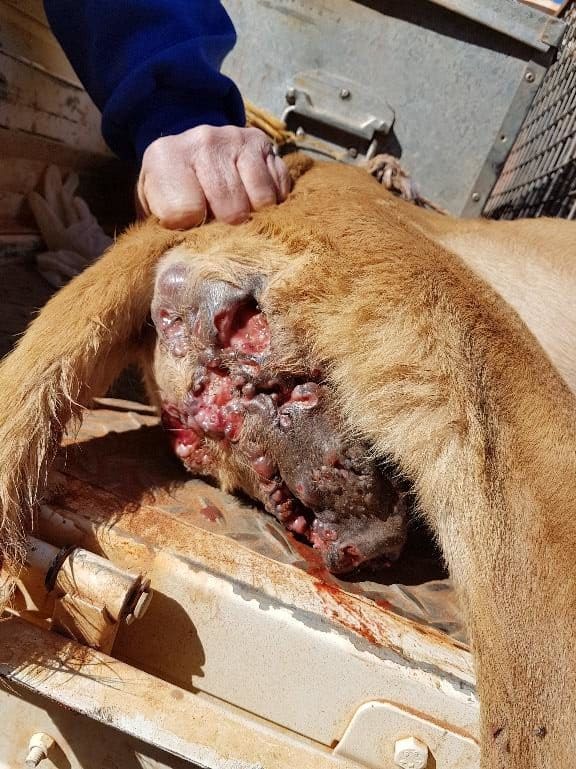CHAPTER EIGHT
Other dog sicknesses EHPs should know about
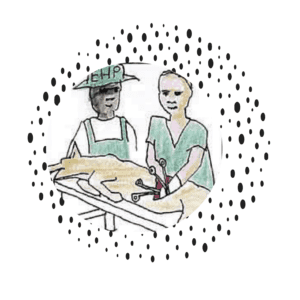
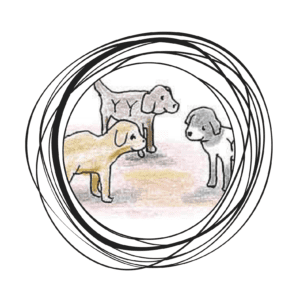

What other dog sicknesses should EHP’s know about?
Chapters 5 & 6 have covered parasites that are common in pets in communities.
In this chapter, you will learn about other sicknesses that dogs in communities can have.
Some of the pictures in this chapter are graphic – be careful if you have a weak stomach!
Canine Transmissible Venereal Tumour (CTVT)
Canine Transmissible Venereal Tumour is also called CTVT or sometimes, ‘Dog Sex Cancer’.
It is a sexually transmitted cancer that affects dogs.
It used to be very common in remote communities, but with regular vet programs, CTVT is being seen less and less.
How does CTVT make dogs sick?
CTVT starts as very small red lumps like match heads inside the dog’s penis or vagina.
The first sign that the dog has CTVT can be blood dripping from the penis or vagina.
As the CTVT gets bigger it can be seen as a lump growing on the vagina or penis.
In females, sometimes CTVT can look like a prolapse of the uterus.
In male dogs the CTVT grows in the penis area. It can be seen on the outside as a swelling under the prepuce. Prepuce is the name for the skin over the penis.
When the prepuce is pulled back the tumour can be seen.
In bad cases the cancer may push the penis outside of the prepuce. The pink bit of the penis is then outside the dog and this can make the dog very sore.
Dogs with CTVTs can have trouble passing urine.
CTVTs can also bleed a lot, and pieces break off them easily.
Dogs with big CTVTs usually become skinny.
Because they look yuck, and drip blood and bacteria everywhere, people usually do not want dogs with CTVT in their house or near the camp.
Dogs with CTVT may not get the food and love they need, and are sometimes treated badly by their owners or other community members.
Can people get CTVT?
No. Only dogs get CTVT.
But dogs with CTVT drip blood around the house. This brings in flies to the house. Bacteria breed in the blood on the floor too. Having a dog with CTVT around the house means a lot of mopping to keep the house clean.
Can CTVT be treated?
Yes. If the CTVT is caught early enough, dogs with CTVT can have operations and special medicine to get rid of the CTVT. This needs to be done by a vet.
When the CTVT is big, euthanasing the dog can be the kindest option.
Any dog with CTVT must be desexed. While they are being desexed, the vet will usually also do surgery to remove some of the cancer.
To make sure all of the cancer is killed, the dog also needs to have special medicine called Vincristine. It is a chemotherapy medicine used to treat cancer.
The medicine can be poisonous for people, so if it is used, the vet must pick up all the dog’s urine and faeces for 3 days after giving the dog the medicine. Because of this, it is best if the dog is taken to a vet clinic so the medicine can be used safely.
If a dog owner wants this treatment for their dog, the EHP can help the owner plan things with the vet.
Working with the community to prevent CTVT.
Not all communities have CTVT.
But if CTVT is in a community and there are lots of dogs breeding, the CTVT will spread very quickly.
Many dog owners in communities do not know that CTVT is a STD and is spread by dogs mating.
If dog owners do not know about CTVT they sometimes blame the EHP or the vet. They may think the medicine that the EHP gave their dog, caused the CTVT, or that the vet made a mistake when they did the desexing operation.
These things can make dog owners lose trust in the animal health and management program.
To prevent CTVT, as the EHP you can:
Run an awareness program with adults in the community.
You should let the community know that CTVT is a STD, and to stop CTVT they need to stop the dogs mating. If dogs never mate they cannot get CTVT.
-
- Dogs can begin breeding around 6 months of age. If they are desexed before this time, they will never get a CTVT.
- It’s important to remember that even if all dogs get desexed, CTVT might still be in the dog population for a while:
– Older dogs may have already caught CTVT before they were stopped from breeding.
– Sometimes the CTVT is so small it cannot be seen when the dog is desexed. Over time it may grow, even if the dog has been desexed.
- Dogs can begin breeding around 6 months of age. If they are desexed before this time, they will never get a CTVT.

Develop a plan to get rid of CTVT
If the community wants to get rid of CTVTs they will need to:
-
- Stop all young dogs breeding before they mate. The best way to stop them breeding is for the vet to desex each dog.
- Check any new adult dogs coming into the community for CTVT, and get them desexed before they breed.
- Talk with the vet and the community about how to deal with dogs that already have CTVT.
If the community wants to get rid of CTVT quickly they will need to decide what they want to do with dogs that already have CTVT.
Some community members might want to get the vet to give their dogs with CTVT vincristine to treat the CTVT. But vincristine can be expensive and hard to give in remote communities, so treating dogs is not always an option.
Other community members might want to get their CTVT dogs euthanased. But euthanasing dogs with CTVT might not be something the community is happy with.
These are big decisions that need lots of yarning. Work with the vet and community to make a plan that the community agree on.
Parvovirus
Parvovirus is mostly a problem for pups that are less than 6 months old.
Parvovirus is caused by a virus and is found where there are lots of pups. It is common to find parvovirus in dog pounds, animal shelters and pet shops.
Parvovirus is also in most communities. Parvovirus can cause all of the pups in a litter to die.
How does parvovirus make dogs sick?
Pups pick up parvovirus from the soil or from other sick dogs.
The virus breeds up in the pup’s gut, and makes the gut lining peel off. The inside of the gut then bleeds badly.
The whole litter is usually sick over about one week.
The pups go off their food. They get very weak, very quickly.
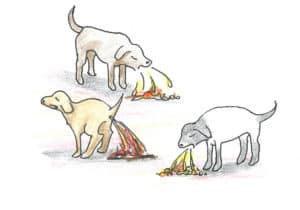
Then they begin to vomit and have bad diarrhoea. The diarrhoea is often bloody looking and smells very bad. It can look a bit like bad hookworm sickness.
If pups are already weak from worms and other sickness they can die before the vomiting and diarrhoea starts.
If pups are not treated most of them will die in the first 3 days of the sickness. They die from losing too much water from their body. This is called dehydration.
Pups with parvovirus can be very hard to treat and many don’t pull through.
If pups are taken to the vet early, sometimes they can be saved by stopping the vomiting and diarrhoea by giving medicine and lots of fluids.
Can people get dog parvovirus?
No. There is a parvovirus that makes people sick but this is not the dog one.
People cannot catch parvo from dogs.
Why do only some dogs get parvovirus?
Most adult dogs in communities have some immunity to parvovirus because they either survived an infection when they were young or have had a vaccination against parvovirus.
They have antibodies in their body that remembers and fights the virus.
Mother dogs that are immune to parvovirus give temporary antibodies to the pups through their milk. These antibodies protect the pup will the pups are still drinking. Once the pups are weaned, the temporary antibodies from their mum’s milk run out and the pups are at risk of getting parvovirus.
Preventing parvovirus
Making people aware of parvovirus
Parvovirus can kill lots of pups, but community members sometimes don’t know what parvovirus is, or why their pups are dying.
As the EHP, you can help people to understand what parvovirus is, and how to prevent it.
You can tell them how it is spread, and that vets can give vaccinations to stop pups from getting sick from parvovirus.
It’s also important that the community knows what parvovirus is, because if people don’t know about parvovirus, and you or the vet gives medicine to worm all the dogs just before there is an outbreak of parvovirus, dog owners might mistakenly think the vet or EHP has poisoned their dogs. They might not realise that their pups actually died from parvovirus. By knowing about parvovirus, you can explain what has really happened to the community.
Stopping parvovirus spreading in the environment
When a pup is sick with parvovirus the virus is breeding in the pup’s gut.
The diarrhoea from these pups has millions and millions of parvoviruses in it. Each parvovirus can live in the soil for up to 18 months. It can also be spread between yards on people’s shoes. This means once it is in a yard or community it is very hard to get rid of.
If pups are kept on floors that can be washed, bleach can be used to kill the virus. A solution of 1:30 household bleach will kill parvovirus on floors but it cannot kill the virus in the soil.
There is no way to kill the virus within soil.
Owners that have had parvovirus in their yards within the last 18 months should be very careful and make sure they get any new puppies vaccinated.
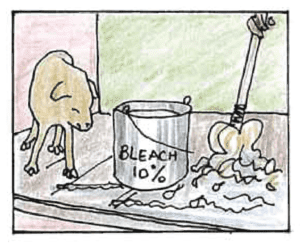
Using vaccinations to prevent parvovirus infections
Dogs can be given a needle to be vaccinated for parvovirus.
Vaccination is a way of getting the pup to make antibodies to remember and fight off any parvovirus infections they come across.
Did you know?
If a pup is already showing signs of parvo, it is too late for them to be vaccinated.
Vaccination will not treat dogs that are already showing signs of parvo.
Vaccination can only be used to prevent parvovirus.
Because they are an added cost, vaccinations are not always included in animal health and management programs.
If there is enough money in the budget, vaccinations are a good addition to other vet treatments.
Parvovirus vaccination are S4 medicines, so they can only be used under the direction of a vet. As the EHP, you can work with your vet to make a vaccination plan for your community.
If your community wants to start a parvovirus vaccination program, it is very important to also stop the dogs breeding.
If dogs are vaccinated against parvovirus, more pups will live and dogs will be healthier. These are very good things, but if a parvovirus vaccination program is started but there is not any desexing or contraceptives to stop dogs from breeding, soon there will be too many dogs.
How to vaccinate
-
- In areas where there is lots of parvovirus, pups can be given the first vaccination as early as 4 weeks old
- The pups should then have booster shots about every 4 weeks until they are 16 weeks old
- The vaccination takes about 10 day to work
- All new pups and dogs coming into communities should be vaccinated at least 10 days before they get to the community
- If this cannot happen they should be vaccinated when the pup or dog first gets to the community. They should then be “quarantined” and kept away from other dogs and any contaminated soil for 10 days
-
- Adult dogs that have grown up in communities where there is lots of parvovirus will probably have some antibodies to parvovirus already. If their immune system gets weak, these antibodies might not work so well, so it is still best to vaccinate adult dogs.
- If adult dogs are vaccinated they should only need one needle each year to protect them from the virus
- There is also a vaccination for adult dogs that lasts for 3 years; talk to your vet about which type of vaccination would work best for your community.
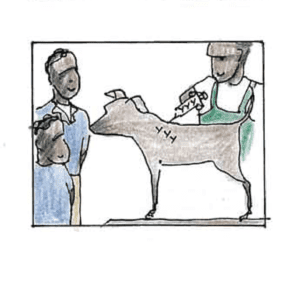
Leptospira bacteria mostly live in the mud around swampy land or where water sits in pools.
The bacteria seem to be in some areas and not in others.
Your vet or the local health clinic should know if your community is in an area where leptospirosis has been found in animals or people.
Did you know?
There are many types of Leptospira in the world.
In the tropics of Australia the main types we see in dogs are Leptospira interrogans var. australis and Leptospira interrogans var. zanoni.
These are also the main types we see in people in the tropics.
The main animals that carry leptospirosis in Australia are rats, bandicoots, pigs and cattle.
These animals may not be sick at all, but the bacteria breed up in their kidneys.
When rats, bandicoots, pigs and cattle urinate, the bacteria move out into the environment in their urine.
The bacteria can survive 6 months in mud and even longer in water.
How does Leptospirosis make dogs sick?
Leptospira bacteria can get into dogs through their skin, or when they drink swampy water.
If the dog has cuts in their skin, it’s even easier for the bacteria to get into their bodies.
The bacteria then get into the blood and quickly breed up in the dog’s liver and kidneys.
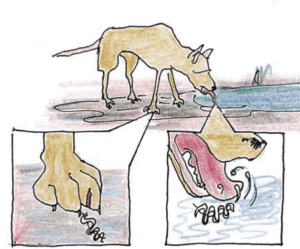
When dogs have leptospirosis, their urine will have lots of Leptospira bacteria in it.
Some dogs can carry Leptospira bacteria in their urine without showing any signs of sickness, but most dogs that get Leptospira infections get very sick and die very quickly.
-
- Dogs with leptospirosis can have:
- fever and weakness coming on very quickly
- blood coming from their nose, and blood in the urine
- yellow gums from liver sickness
Dogs can die about 24 hrs after first getting sick from leptospirosis.
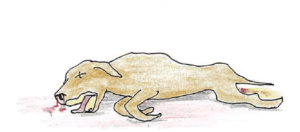
Blood tests and urine samples can show if a dog has leptospirosis.
Antibiotics will kill Leptospira bacteria, but dogs with leptospirosis often die from liver and kidney failure before antibiotics have time to work.
Dogs can be vaccinated for Leptospira interrogans var. australis.
Talk to your vet to see if leptospirosis vaccination would be good for dogs in your community.
How does Leptospirosis make people sick?
People can get infected with Leptospira bacteria from:
-
- contact with urine of an infected animal (including dogs)
- drinking or walking through swampy water with Leptospira in it
- getting dirt or mud on them that has Leptospira in it
In people, leptospirosis can cause mild flu-like signs (like fevers, headaches, and muscle aches), or if it attacks the kidneys and liver, can cause serious health problems.
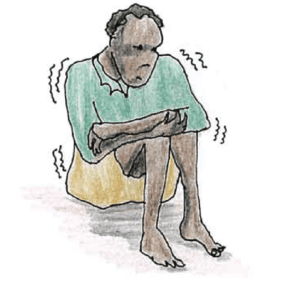
Community awareness programs for leptospirosis
If leptospirosis is a problem in your area, as the EHP, you can also work with the local health clinic to raise community awareness of leptospirosis. The awareness program could include information about:
-
- Washing hands after touching animals or playing in mud.
- Washing skin sores with clean soapy water, then covering them up.
- Not handling urine from sick dogs.
- Rodent control.
- Stopping dogs and children playing in swampy country.
- Stopping dogs hunting wildlife that may be carrying leptospirosis.
- Stopping water pooling in yards.
- Not drinking swampy water
- Wearing shoes so the bacteria can’t move through people’s skin.
As the EHP, you can also work with your vet and clinic staff to find out if animals in the community are carrying leptospirosis and if it is the same type that is making people sick. AMRRIC can also help you to work with researchers to find out more about leptospirosis in your community.
Brucellosis
Brucellosis is the name of the sickness caused by Brucella bacteria.
Brucella bacteria can only be seen with a microscope.
There are many different types of Brucella bacteria all over the world that affect many different species.
Brucella suis infections can cause health problems for pigs, dogs and people.
Brucella suis is found in feral pigs in QLD and NSW. More research is being done to see if Brucella suis is found in feral pigs in other states.
Did you know?
Brucella suis can pass from feral pigs, to dogs and then from dogs to humans.
People can also get Brucella suis directly from feral pigs.
People who hunt pigs need to know about Brucella suis.
How does Brucella suis make dogs sick?
Dogs that go hunting for pigs or have been fed raw pig meat can get infected with Brucella suis.
Some dogs may have no signs of sickness from Brucella suis. Other dogs may have, enlarged testicles, back pain or limping. In female dogs, Brucellosis can also cause abortions or stillbirths.
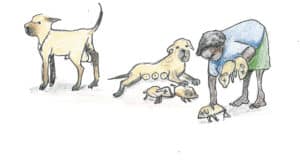
Dogs that have Brucella suis infections can keep putting the bacteria into the environment. This can be dangerous for other dogs and for people.
Treating Brucella suis in dogs is hard. Antibiotics may not fully fix a dog with brucellosis, and there are no other treatments that guarantee to cure the infection.
Because of their risk to human health, most dogs with brucellosis are euthanased. If their owner does not want to have the dog euthanased, the infected dog has to be treated with antibiotics for a long time. Infected dogs also have to be desexed.
Because it can spread between dogs, if one dog in a house has Brucella suis, all other dogs it lives with should be checked too.
How does Brucella suis make people sick?
Brucellosis in people is not very common, but it can cause serious health problems when it does occur.
Hunting feral pigs is the main way that people come into contact with the Brucella suis bacteria.
People can become infected by touching the meat or body fluids of an infected pig. The Brucella suis bacteria can get in through the skin or be swallowed or breathed in.
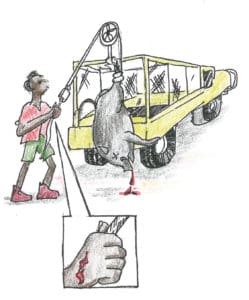
People can also catch Brucella suis from a dog that is infected, even if that dog is not showing signs of sickness.
In a dog that has Brucellosis suis, the bacteria will be in the dog’s blood, urine, vaginal discharges, semen or uterine fluid (in the baby bag).
People might catch Brucella suis if they are helping an infected female dog give birth to puppies, or if they come into contact with an infected dog’s urine.
Some people might not get sick from Brucellosis, but in other people, Brucellosis can cause:
-
- flu-like illness
- for males, sore or swollen testicles
- abortion in pregnant women
- in rare cases, serious sickness or even death.
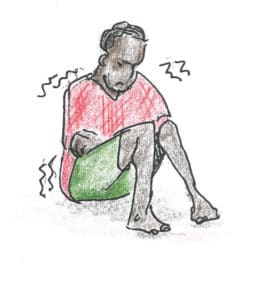
Infection can last for days or months but can sometimes last for a year or more. In some people, the sickness keeps coming back to make the person sick for a long time.
When Brucellosis is found in people, the clinic must report the case to the government.
Sometimes the government may want to look at how the person caught Brucellosis. They might want to test the person’s dogs for Brucella suis too.
Community awareness programs for Brucellosis
As the EHP, you can work with the clinic to help the community stop Brucellosis in dog and people. This is especially important if pig hunting is popular in your community.
You might like to run a community awareness program about Brucellosis and how it is spread. You can share information like:
-
- Do not feed dogs uncooked feral pig meat or offal.
- Desex dogs so that infected dogs can’t breed and spread Brucella suis.
- If using dogs for hunting, do not allow dogs to play with, or feed on pig carcasses.
- Be aware of Brucellosis if you find sick pigs or boars with swollen testicles.
- Cover any skin cuts or sores if you are going pig hunting. Don’t let pig blood, urine or other fluids splash into your mouth or eyes.
- Wash down dogs and their protective plates after hunting trips, to help to remove Brucella bacteria that might be on their skin.
- Pregnant women and people with weak immune systems shouldn’t have contact with pig hunting dogs (or feral pigs).
- Wear gloves when helping female dogs give birth, or cleaning up dog urine.
- If dogs get hurt while hunting, wear gloves to wash and clean the wounds and take the dog to a vet – don’t try to fix these wounds yourself.






